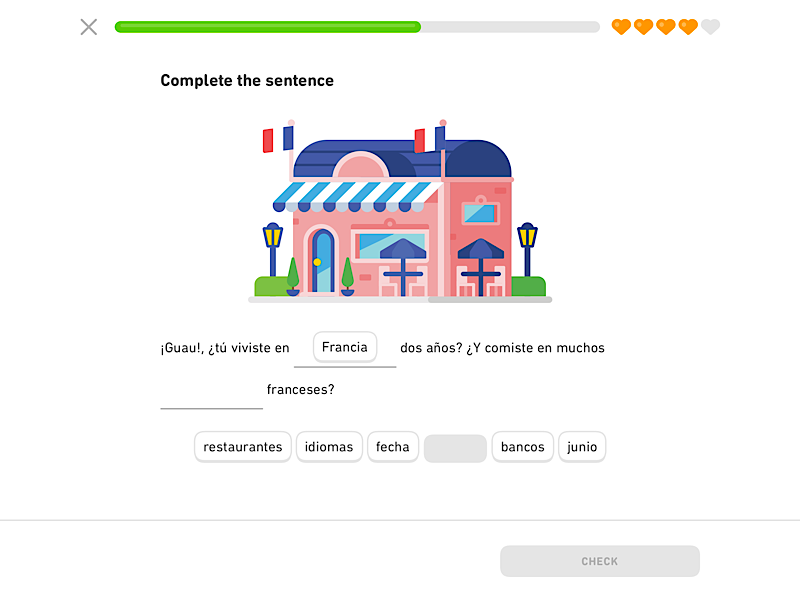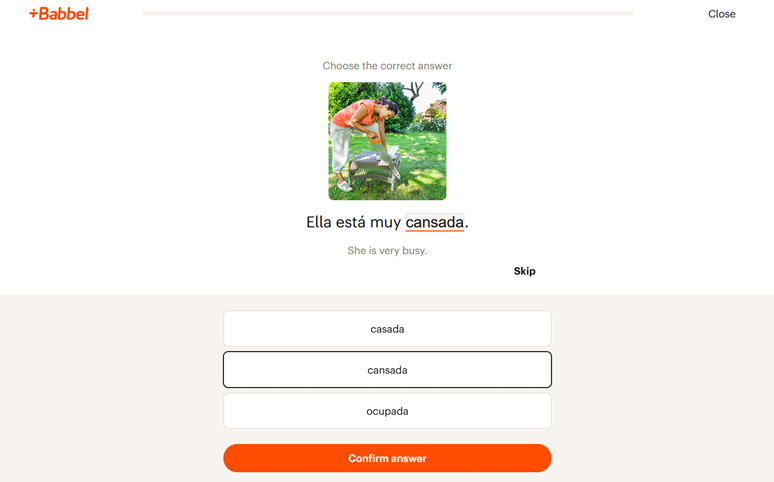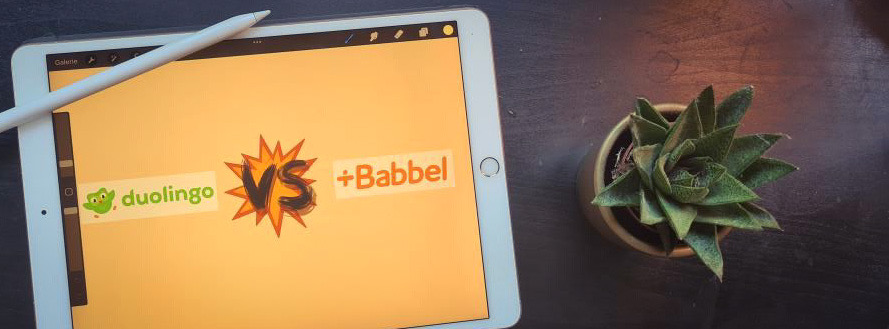Image rights: © Katrin Adam
Duolingo or Babbel – which language course is better? We tested both solutions and compare them in this article. Which one will end up ahead by the end of this Duolingo vs. Babbel match?
Table of Contents
Quick Take: We’d rather go with Babbel. Its course structure is far more logical and leads to better results. However Duolingo also has some advantages.
Duolingo vs. Babbel – The Competitors at a Glance

Duolingo is one of the most recognizable platforms—thanks in large part to its lovable mascot, Duo.
vs.

Babbel is Germany’s most successful language app. It’s well-structured and tends to impress.
Similarities: Where Duolingo and Babbel Overlap
Duolingo and Babbel may not look that different at first glance. And although there are major differences—and ultimately a clear winner in this head-to-head—they still share a few things in common. Both Babbel and Duolingo can be used on any device (through their apps or web interfaces), complete with all features.
Each platform is promoted as a primary resource for language study, with an emphasis on mobile-friendly learning sessions that fit easily into busy schedules.
Differences: Where Duolingo and Babbel Diverge
Now it’s time to dig into what sets them apart. Although both are advertised similarly, Babbel is much closer to a traditional language course than Duolingo. Babbel includes learning phases, exercises, and grammar explanations, whereas Duolingo leans on intuitive context-based learning—without any real explanations or background info. Babbel has no ads, whereas Duolingo’s free version is supported by frequent advertising.

‒ The Best Language Course of 2025 ‒
We’ve tested dozens of language courses…
But only ONE takes the #1 spot!
Babbel also offers live language lessons with its “Babbel Live” program, something Duolingo doesn’t do. In fact, the course design differs fundamentally between the two. Keep reading to see how each option does it:
Duolingo or Babbel – Scope and Features
Babbel offers 13 foreign languages for English-speaking users, while Duolingo currently has over 40. Duolingo’s extra features revolve around reviewing mistakes and customizing your practice, but you can only unlock them via a paid subscription, Ai as well if you pay even more. There’s no additional core content to open up.
Babbel recently removed a few of its once-popular features, similar to Duolingo, but it still offers add-on courses that focus on specific topics. For instance, you can drill down on workplace-related vocabulary if you need a particular skill set. AI is also integrated in a standard subscription here. We think this is a plus, but Duolingo gets the point for more languages as well.
– Point for Both –
While the next category may not be the core of a language course, a clean, intuitive interface is an advantage. Nobody wants to click through multiple tabs just to find what they need. So, how do these two contenders fare in this area?
Duolingo vs. Babbel – User-Friendliness
Both platforms feature attractive, well-organized interfaces. However, Babbel is typically easier for less tech-savvy users: all the buttons are clearly labeled, and the learning path is straightforward and easy to follow. Although Duolingo isn’t exactly difficult to use, you’ll sometimes have to navigate multiple tabs, lists, and achievements to get where you want. This point goes to Babbel!
– Point for Babbel –
All of that is nice, but let’s get down to the heart of the course: the learning method and how effectively it’s implemented. So who does better here, Duolingo or Babbel?
Duolingo or Babbel – Learning Concept
Babbel (right side) uses a classic school-like approach. Lessons are structured by theme and split into an intro phase – where you learn new vocabulary and grammar points – followed by practice tasks to reinforce what you just learned.


Duolingo (left side), on the other hand, relies on a string of consecutive exercises that occasionally introduce new vocabulary. Unfortunately, you’ll sometimes come across random and somewhat nonsensical sentences. There’s no learning phase without points, and absolutely no grammar explanations. Context-based learning can work well, but not quite in Duolingo’s style. For instance, the Birkenbihl method used by Rocket Languages implements a more effective context-based approach. So again:
– Point for Babbel –
Even the best course does you no good if you never open it. Besides a strong method, motivation elements matter, too. So how do Babbel and Duolingo handle keeping you motivated?
Duolingo or Babbel – Motivation
This one definitely goes to Duolingo: No other platform does a better job delivering playful motivation with mascots, regular challenges, and connecting you to friends. Its lessons are short, fit easily into your day, and you’re encouraged to maintain a daily “streak.” That said, the ever-present ads in the free version can feel demotivating. We’ll touch on that in the Value for Money section.

‒ Language Course Discounts ‒
Find the best discounts and exclusive coupons for top
language courses here!
+ + + Limited-Time Deals +++ Some Offers Expiring Soon +++ Don’t Miss Out! + + +
Babbel uses short lessons, too, but it doesn’t have any unique motivational features. Older community features that once kept people engaged have been removed (the same happened at Duolingo, sadly). That’s too bad – so in this category, we vote:
– Point for Duolingo –
A quality language course is great, but the price should match what you’re getting. More features and languages, plus a more comprehensive method, can justify a higher cost. How do Duolingo or Babbel stack up on that front?
Duolingo vs. Babbel: Value for Money
Duolingo is well-known for having lots of free content. Unfortunately, you pay for that with countless ads, which sometimes last nearly as long as the rather short lessons themselves. We have to dock points for the idea of flooding a learning environment with advertising.
Babbel, by contrast, doesn’t offer free material, but you can learn a language ad-free starting at $8,95 a month (depending on your plan). You can also find a Babbel lifetime offer from time to time, letting you pay around $299 for lifelong access to all 13 languages – pretty sweet!
For that price, Babbel delivers a high-quality, traditional course concept with plenty of explanations and support. Duolingo can be a nice free supplement or a basic intro, but even the paid version (here’s Duolingo’s cost overview) won’t help you achieve true fluency on its own. So once again:
– Point for Babbel –
We’ve now covered five categories in detail. Let’s look at the final results:
Points Summary

Scope
Motivation
vs.

Scope
User-Friendliness
Learning Concept
Value for Money
Conclusion – Duolingo or Babbel: Who Wins?
In a direct comparison of Duolingo vs. Babbel, Babbel takes the win with a 4:2 score. Its solid traditional concept with thorough explanations, plus its wider selection of languages, really tip the scales. Babbel could still use a bit more in the motivation department, but that’s where outside tips and tricks – like self-nudging or the one-meter hack – come in.
Does that mean you should purchase Babbel without hesitation? If the only question is Babbel or Duolingo, then yes, probably. We recommend Duolingo mainly for beginners and people who really struggle with keeping themselves motivated. Otherwise, we highly recommend checking out Babbel vs. Mondly!
No matter which course you ultimately choose, consistent practice is crucial. If you want more options, check out our Top 10 list of the best practice courses for different needs and budgets.
